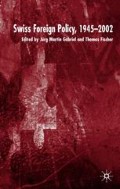Abstract
In the area of arms control and disarmament, Swiss policy has undergone a significant shift since the Second World War. In the first few years after the war, the issue did not feature on the Swiss foreign policy agenda. The advent of the Nuclear Non-Proliferation Treaty (NPT) in the 1960s, however, triggered a lengthy discussion. It challenged Switzerland to weigh a number of different and conflicting interests — mainly military and economic — and to come to a decision for or against the treaty. In contrast, agreements like the Biological Weapons Convention (BWC) and the Limited Test Ban Treaty (LTBT) were signed and ratified quickly and without much controversy and debate. Those treaties did not entail practical obligations for the country. It must also be added that as a non-member of the United Nations (UN) and the Geneva Conference on Disarmament (CD),1 Switzerland’s participation in the Conference on Security and Co-operation in Europe (CSCE, later OSCE) was its only opportunity during the Cold War to engage in multinational arms control negotiations as an equal partner.
Access this chapter
Tax calculation will be finalised at checkout
Purchases are for personal use only
Preview
Unable to display preview. Download preview PDF.
Notes
Peter Hug, Biologische und chemische Waffen in der Schweiz zwischen Aussen-, Wissenschafts- und Militärpolitik, Studien und Quellen 23 (Bern: Schweizerisches Bundesarchiv, 1997 ), pp. 24–34.
Gary T. Gardner, Nuclear Nonproliferation: A Primer ( Boulder/London: Lynne Rienner Publishers, 1994 ), pp. 38–9.
Nicolas Michel, La prolifération nucléaire: Le régime de non -prolifération des armes nucléaires et la Suisse ( Fribourg: Editions Universitaires Fribourg, 1990 ), p. 265
Theodor H. Winkler, Kernenergie und Aussenpolitik: Die internationalen Bemühungen um eine Nichtweiterverbreitung von Kernwaffen und die friedliche Nutzung von Kernenergie in der Schweiz ( Berlin: Berlin Verlag, 1981 ), pp. 53–60.
On the early phase of Swiss CSCE commitment, see: Christoph Breitenmoser, Sicherheit für Europa: Die KSZE-Politik der Schweiz bis zur Unterzeichnung der Helsinki-Schlussakte zwischen Skepsis und aktiven Engagement, Zürcher Beiträge zur Sicherheitspolitik und Konfliktforschung 40 ( Zürich: Forschungsstelle für Sicherheitspolitik und Konfliktanalyse der ETH Zürich, 1996 )
Hans -Jörg Renk, Der Weg der Schweiz nach Helsinki: Der Beitrag der schweizerischen Diplomatie zum Zustandekommen der Konferenz über Sicherheit und Zusammenarbeit in Europa (KSZE), 1972–1975 ( Bern/Stuttgart/Wien: Paul Haupt, 1996 ).
Fred Tanner, Die Schweiz und Rüstungskontrolle: Grenzen und Möglichkeiten eines Kleinstaates, Zürcher Beiträge zur Sicherheitspolitik und Konfliktforschung 14 (Zürich: Forschungsstelle für Sicherheitspolitik und Konfliktanalyse der ETH Zürich, 1990 ), pp. 4–7.
André Schaller, Schweizer Neutralität im West-Ost-Handel: Das Hotz-Linder -Agreement vom 23. Juli 1951 ( Bern/Stuttgart: Verlag Paul Haupt, 1987 ).
Jürg Martin Gabriel, The American Conception of Neutrality after 1941 ( New York: Macmillan, 1988 ), pp. 116–22.
For a survey of the CWC negotiations, see: Perry J. P. Robinson, Thomas Stock and Ronald G. Sutherland, ‘The Chemical Weapons Convention: the Success of Chemical Disarmament Negotiations’, in SIPRI Yearbook 1993 on World Armaments and Disarmament ( Oxford: Oxford University Press, 1993 ), pp. 705–34.
Marcel Gerber, ‘Schweizerische Rüstungskontrollpolitik in einem neuen internationalen Umfeld: Das innovative Engagement für ein Personenminen-Verbot als Modell für die Zukunft?’, in Kurt R. Spillmann and Andreas Wenger (ed.), Bulletin 1999 zur schweizerischen Sicherheitspolitik ( Zürich: Forschungsstelle für Sicherheitspolitik und Konfliktanalyse der ETH Zürich, 1999 ), p. 84.
Lucius Caflisch, ‘Ist ein Totalverbot von Personenminen in Sicht? Vor der nächsten Runde im Ottawa-Prozess’, NZZ, 21 August 1997, p. 7.
David C. Atwood, Tackling the Problem of Anti-Personnel Landmines: Issues and Developments, Zürcher Beiträge zur Sicherheitspolitik und Konfliktforschung 51 ( Zürich: Forschungsstelle für Sicherheitspolitik und Konfliktanalyse der ETH Zürich, 1999 ).
On the Swiss chairmanship of the OSCE, compare Laurent Goetschel (ed.), Vom Statisten zum Hauptdarsteller: Die Schweiz und ihre OSZE-Präsidentscha ft ( Bern/Stuttgart/Wien: Paul Haupt, 1997 ).
Erwin Dahinden, ‘Rüstungskontrolle und Kriegsvölkerrecht: schweizerische Sicherheitskooperation mit Leistungsausweis’, in Hans Eberhart and Albert A. Stahel (ed.), Schweizerische Militärpolitik der Zukunft. Sicherheitsgewinn durch stärkeres internationales Engagement ( Zürich: NZZ Verlag, 2000 ), p. 180.
Copyright information
© 2003 Palgrave Macmillan, a division of Macmillan Publishers Limited
About this chapter
Cite this chapter
Heinzer, A.E. (2003). Swiss Arms Control Policy: From Abstention to Participation. In: Swiss Foreign Policy, 1945–2002. Palgrave Macmillan, London. https://doi.org/10.1057/9780230500242_7
Download citation
DOI: https://doi.org/10.1057/9780230500242_7
Publisher Name: Palgrave Macmillan, London
Print ISBN: 978-1-349-51136-5
Online ISBN: 978-0-230-50024-2
eBook Packages: Palgrave History CollectionHistory (R0)

